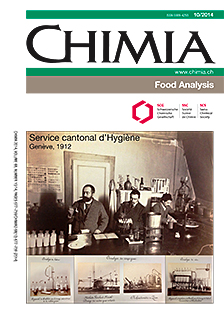Development and Validation of a P-35S, T-nos, T-35S and P-FMV Tetraplex Real-time PCR Screening Method to Detect Regulatory Genes of Genetically Modified Organisms in Food
DOI:
https://doi.org/10.2533/chimia.2014.701Keywords:
Gmo detection, P-35s, P-fmv, Screening, T-35s, Tetraplex real-time pcr, T-nosAbstract
In routine analysis screening methods based on real-time PCR (polymerase chain reaction) are most commonly used for the detection of genetically modified (GM) plant material in food and feed. Screening tests are based on sequences frequently used for GM development, allowing the detection of a large number of GMOs (genetically modified organisms). Here, we describe the development and validation of a tetraplex real-time PCR screening assay comprising detection systems for the regulatory genes Cauliflower Mosaic Virus 35S promoter, Agrobacterium tumefaciens nos terminator, Cauliflower Mosaic Virus 35S terminator and Figwort Mosaic Virus 34S promoter. Three of the four primer and probe combinations have already been published elsewhere, whereas primers and probe for the 35S terminator have been developed in-house. Adjustment of primer and probe concentrations revealed a high PCR sensitivity with insignificant physical cross-talk between the four detection channels. The sensitivity of each PCR-system is sufficient to detect a GMO concentration as low as 0.05% of the containing respective element. The specificity of the described tetraplex is high when tested on DNA from GM maize, soy, rapeseed and tomato. We also demonstrate the robustness of the system by inter-laboratory tests. In conclusion, this method provides a sensitive and reliable screening procedure for the detection of the most frequently used regulatory elements present in GM crops either authorised or unauthorised for food.Downloads
Published
2014-10-29
Issue
Section
Scientific Articles
License
Copyright (c) 2014 Swiss Chemical Society

This work is licensed under a Creative Commons Attribution-NonCommercial 4.0 International License.
How to Cite
[1]
A. Eugster, P. Murmann, A. Kaenzig, A. Breitenmoser, Chimia 2014, 68, 701, DOI: 10.2533/chimia.2014.701.







